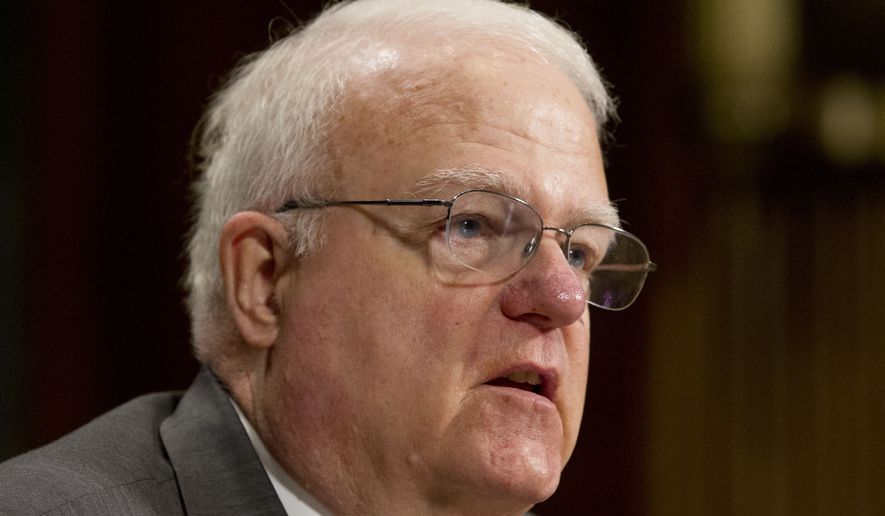The government today can’t even list all of the federal crimes it could use to charge someone — a symbol of just how out of control the national criminal justice system is, said Reps. F. James Sensenbrenner Jr. and Robert C. Scott, two senior congressmen who hope to change the face of the nation’s prison population.
Mr. Sensenbrenner, a white Wisconsin Republican, and Mr. Scott, a black Virginia Democrat, have teamed up for what they hope will be the biggest reform of criminal justice in decades. They hope to prevent people from going to prison unnecessarily in the first place, and to help them reform if they do end up behind bars and avoid going back once they are released.
It’s a hefty task at a time when get-tough slogans continue to be political winners, but the two men see an opening.
“I think there will probably be fewer trials and perhaps more plea bargains,” Mr. Sensenbrenner said in an interview along with Mr. Scott hours before they introduced their bill late last month. “We’re changing the law more relative to penalties and what happens to prevent people who go to prison from coming out and going right back in as a hardened criminal.”
Their 144-page bill is based on advances in states, which have been well ahead of Congress in taking a look at tight budgets, burgeoning prison populations and generations of people lost to lives of incarceration and recidivism.
U.S. incarceration rates are the highest in the world, and most inmates are in state prisons or local jails. But over 200,000 are in federal custody. That total has risen from about 25,000 when President Reagan took office in 1981 to a peak of more than 219,000 in 2013, slipping to 214,149 in 2014.
SEE ALSO: Kathryn Steinle killing fuels outrage over Democrats’ deportation opposition
The congressmen ticked off Hawaii, South Dakota and Texas — which have a range of incarceration rates — as just some of the places that have paved the way for changes, and said it’s thanks to those states’ willingness to experiment that statistics are available to show what works and what doesn’t.
That is particularly important in countering the get-tough approach that voters tell pollsters they prefer.
“One of the things that’s significant is the idea that we’re looking at research and evidence,” Mr. Scott said. “When you’re doing crime policy, it’s usually sound bites and slogans. If you get away from the slogans and stick with the evidence, you’ll find there’s a lot of common ground — on the left and the right.”
Big changes
Their bill would make substantial changes at all levels of the criminal justice system. Among them:
⦁ Low-level offenders would be steered toward probation instead of prison, while jail space would be kept for violent and high-level criminals. The “three-strikes” penalty imposing life in prison for a third offense would be curtailed.
SEE ALSO: Donald Trump’s comments on illegal immigrants divide 2016 GOP hopefuls
⦁ In trials, federal prosecutors would be required to disclose almost all of their investigative files, and they would have to notify each defendant whose case involved a technician, law enforcement officer or someone else deemed to have provided flawed analysis or engaged in misconduct.
⦁ Those sentenced to prison time would be encouraged to get clean and stay clean when they leave, with individualized case plans to match situations and a graduated set of penalties for those on probation so minor mistakes don’t send someone back behind bars immediately.
Mr. Sensenbrenner has been in the middle of a number of high-profile bipartisan bills in recent years, with varying degrees of success.
He recently shepherded through the USA Freedom Act, which rewrote controversial portions of the Patriot Act — which also happened to be a Sensenbrenner-drafted bill from his time as chairman of the House Judiciary Committee in the early 2000s.
The Wisconsin Republican also hooked up with top Democrats on a rewrite of the Voting Rights Act after a Supreme Court decision overturned a key test for how to apply that law. The Republican-led Congress has shown little appetite for action on that measure.
One important yardstick for the criminal justice reform bill’s chances is whether the two men can win support of Rep. Bob Goodlatte, the Virginia Republican who now chairs the House Judiciary Committee.
He is not a co-sponsor of the bill, though he has shown an interest in looking at the issue. His committee hosted a listening session hours before Mr. Sensenbrenner and Mr. Scott introduced their bill.
“The House Judiciary Committee is taking a step-by-step approach to address a variety of criminal justice issues, including overcriminalization, sentencing reform, prison and re-entry reform, protecting citizens through improved criminal procedures and policing strategies, and civil asset forfeiture reform,” a Judiciary Committee aide said. “The committee will give due consideration to all proposals offered by interested members on this topic.”
A big part of the push by Mr. Sensenbrenner and Mr. Scott is to take stock of the breadth of federal crimes — particularly violations of regulations that carry criminal penalties.
“We don’t even have a list of them,” Mr. Scott said.
“Believe me, we tried,” Mr. Sensenbrenner said. “We asked [the Congressional Research Service] to give us a list of them, and we got a letter back saying there are so many of them we don’t have the staff to compile them.”
• Stephen Dinan can be reached at sdinan@washingtontimes.com.




Please read our comment policy before commenting.